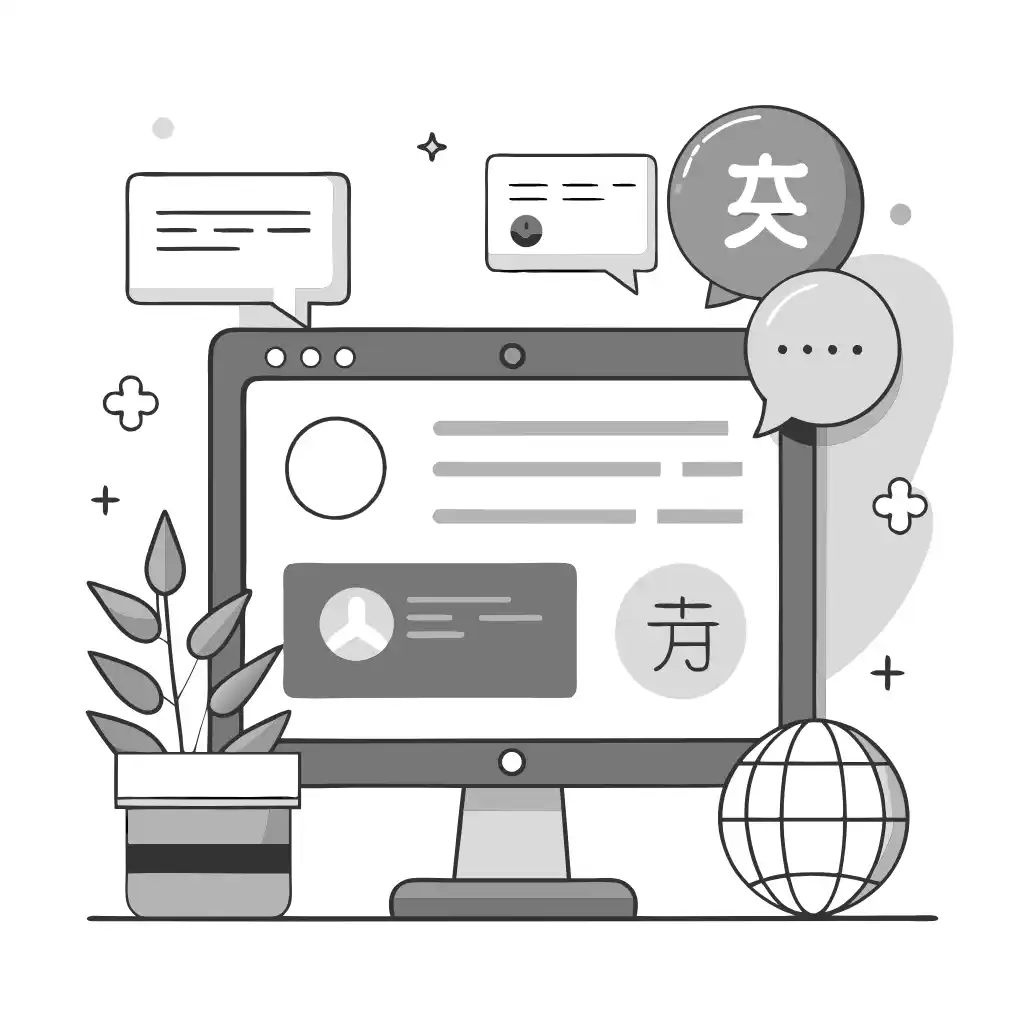Strategie pro vytvoření vícejazyčného webu WordPress
V dnešním globálním digitálním prostředí musí weby WordPress sloužit publiku po celém světě hovořícím různými jazyky. Výzkum ukazuje, že více než polovina online uživatelů preferuje procházení stránek ve svém rodném jazyce. Lokalizace vašeho webu WordPress otevírá dveře novým trhům a zákazníkům.
Tento komplexní průvodce zkoumá osvědčené techniky pro překlad WordPress pomocí automatického a lidského překladu. Čtěte dále a zjistěte strategie, které může každá firma dodržovat, aby snadno přizpůsobila svůj web WordPress pro globální úspěch.


Hodnota vícejazyčného webu WordPress
Vícejazyčný web přináší základní výhody:
Rozšířený dosah – Využijte lukrativní poptávku zahraničních návštěvníků poskytováním lokalizovaného obsahu. Získejte organickou návštěvnost.
Vyšší konverze – Návštěvníci tráví více času na stránkách ve svém vlastním jazyce. Lokalizované zážitky zvyšují zapojení a prodej.
Budoucnost – Budoucnost webu směřuje ke globálnímu pluralismu. Stránky pouze v angličtině omezují růst.
Pozitivní branding – Podpora více jazyků vyjadřuje kulturní respekt a progresivní myšlení.
Se správným řešením je vytvoření přeloženého webu WordPress jednoduché, ale transformativní. Odemyká nové globální příležitosti díky lepší rezonanci s různorodým publikem po celém světě.
Výběr ideálního přístupu k překladu
Při překladu webu WordPress existují dvě základní možnosti – ruční lidský překlad nebo automatický strojový překlad. Jak si podniky vybírají?
Ruční lidský překlad zahrnuje najímání lingvistů, aby překládali obsah po částech. To zajišťuje vysokou kvalitu, ale má nevýhody:
- Velmi časově náročné a drahé v měřítku
- Je obtížné udržet konzistenci na velkém webu
- Je náročné udržovat překlady aktualizované, jak se web vyvíjí
- Plně nevyužívá obsah celého webu pro kontext
Naproti tomu automatický strojový překlad využívá pokročilou umělou inteligenci k okamžitému překladu textu za zlomek nákladů. Zatímco kvalita byla historicky pochybná, moderní systémy, jako je Google Translate, udělaly dramatický pokrok díky neurálnímu strojovému učení.
Omezení strojového překladu zahrnují nepřesnosti ve složitém textu, nedostatek nuance terminologie a nesprávnou gramatiku. Tyto mezery však lze vyřešit pomocí hybridních modelů, které spojují automatizaci s lidskou editací profesionály.


Ideální řešení: Smíšený model
Nejúčinnější metoda kombinuje automatizovaný strojový překlad pro zpracování hromadných požadavků se selektivním profesionálním lidským překladem klíčového obsahu.
Tento hybridní přístup vyvažuje náklady, rychlost a kvalitu. Automatizace efektivně překládá většinu obsahu webu. Lidský dohled pak zpřesňuje a ověřuje stránky s vysokou hodnotou, aby byla zachována integrita.
Pokročilé překladatelské platformy umožňují tento kombinovaný model prostřednictvím funkcí, jako jsou:
- Integrace s platformami CMS, jako je WordPress
- Připojení API k motorům strojového překladu, jako je Google a DeepL, umožňující automatizaci
- Nástroje pro správu výstupů strojového překladu
- Možnost označit konkrétní stránky pro lidský překlad
- Služby bezproblémového objednání profesionálních lidských překladů
- Podpora spolupráce s externími překladateli
- Průběžná překladová paměť pro zajištění konzistence terminologie
Hybridní strategie přináší to nejlepší z obou světů. Pro weby WordPress jsou příkladem tohoto kombinovaného přístupu platformy jako ConveyThis.
Optimalizace přeložených stránek WordPress pro vícejazyčné SEO
Přivedení kvalifikovaného provozu na přeložené weby WordPress vyžaduje správnou on-page a technickou optimalizaci. Postupujte podle těchto doporučených postupů:
- Zahrňte lokalizované názvy stránek a meta popisy, abyste zvýšili hodnocení v zahraničních vyhledávačích, jako je Baidu nebo Yandex.
- Přizpůsobte obsah tak, aby obsahoval relevantní klíčová slova a fráze přizpůsobené vyhledávacím zvyklostem a specifikům každého jazyka.
- Implementujte poznámky hreflang k označení alternativních jazykových verzí stránek pro procházení vyhledávačem.
- Pro jazykové verze používejte spíše struktury podadresářů, jako je example.com/es, než samostatné domény.
- Zajistěte, aby přeložené adresy URL měly jednotnou strukturu a vzor, abyste předešli problémům s duplicitním obsahem.
- Ověřte, že soubory Sitemap XML obsahují odkazy na všechny přeložené stránky, aby se usnadnilo indexování.
- Přidejte alternativní text a popisky obrázků v každém jazyce, abyste popsali obrázky pro místní uživatele.
Se správnými základy SEO využívají přeložené weby WordPress svůj plný potenciál návštěvnosti globálně.


Nejlepší tipy pro spuštění nového vícejazyčného webu WordPress
Společnosti spouštějící nové webové stránky získávají výhody tím, že od počátku plánují vícejazyčnost:
- Zjistěte, které jazyky budou vaše cílové trhy vyžadovat pro zapojení a konverze.
- Rozpočet na profesionální lidský překlad alespoň vašich hlavních stránek v základních jazycích zpočátku.
- Od samého počátku začleňte do návrhu a vývoje vícejazyčné osvědčené postupy SEO.
- Použijte překladatelskou platformu s automatizačními funkcemi k řazení dalšího obsahu s nižší prioritou pro strojový překlad.
- Postupně zavádějte další jazyky na základě návštěvnosti a potenciálu příjmů.
- Analyzujte analýzy a identifikujte rostoucí poptávku návštěvníků z konkrétních zemí, abyste mohli určit prioritu jazyka.
Vytváření vícejazyčných funkcí předem snižuje dlouhodobé náklady a zakódování ve srovnání s dovybavením funkcí překladu do živého webu.
Překlad stávajících stránek WordPress v 5 krocích
Máte již aktivní web WordPress? Žádný problém. Při překladu stávajícího obsahu dodržujte tyto doporučené postupy:
- Nainstalujte si překladatelský plugin jako ConveyThis a nakonfigurujte jazyky.
- Povolte automatizaci strojového překladu veškerého existujícího obsahu do požadovaných jazyků.
- Zkontrolujte chybové výstupy stroje a upravte je pomocí vestavěných nástrojů pro úpravy.
- Označte důležité stránky a objednejte si profesionální lidské překlady prostřednictvím platformy.
- Zaveďte SEO optimalizaci a průběžné lokalizační pracovní postupy.
Tento zjednodušený proces umožňuje překládání velkých již existujících webů WordPress.


Příklady úspěchu vícejazyčného WordPressu ze skutečného světa
Přední značky využily vícejazyčný překlad WordPress ke zvýšení zapojení a prodeje v zahraničí:
- Kanadská společnost zabývající se elektronickým obchodováním zaznamenala dvojnásobný nárůst mezinárodních konverzí poté, co spustila německé a francouzské verze svého webu WooCommerce.
- Australský B2B startup snížil náklady na překlady do finštiny o více než 80 % tím, že spojil strojový překlad s profesionálními úpravami vs. outsourcing celého webu.
- Britský prodejce módy zvýšil návštěvnost webových stránek ve španělštině a italštině o více než 90 % poté, co lokalizoval obsah svého webu WordPress do těchto jazyků.
- Americká softwarová společnost zkrátila čas potřebný k překladu nových článků centra nápovědy a dokumentace do 8 jazyků z 20 hodin týdně na pouhých 5 tím, že zavedla automatizaci.
Důkaz je jasný. Se správnou strategií a řešeními přináší vytvoření vícejazyčného webu WordPress hmatatelný globální růst a příjmy.
Překonání běžných překladatelských výzev
Navzdory výhodám mohou společnosti narazit na překážky týkající se vícejazyčného provádění WordPress:
Cena: Rozpočtová omezení mohou omezit objem překladů. Optimalizujte výdaje pomocí automatizace prolínání.
Zdroje: Štíhlé týmy mohou mít potíže se správou velkých překladatelských projektů v mnoha jazycích bez vyčerpání pozornosti. Hledejte podporu outsourcingu.
Kvalita: Vyvážení nákladů a kvality u strojového i lidského překladu vyžaduje pečlivost. Používejte ověřovací pracovní postupy.
Údržba: Udržování synchronizovaného přeloženého obsahu během probíhajících změn WordPress vyžaduje disciplínu. Nástroje pro správu překladů pomáhají.
Se správným přístupem a partnery jsou tyto překážky překonatelné pro organizace všech velikostí a rozpočtů.


Budoucnost vícejazyčných zážitků
I když je technologie strojového překladu již dnes životaschopná, bude se nadále vyvíjet prostřednictvím výzkumu a růstu dat, aby zvládla více jazyků s většími nuancemi.
Globální digitální přijetí zároveň rychle stoupá, zejména na mobilních zařízeních. To rozšiřuje adresné celosvětové publikum.
Výsledkem je, že úspěšné spouštění a provozování vícejazyčných webových stránek jen zvýší strategickou nutnost a složitost. Robustní vícejazyčné schopnosti a procesy se ukáží jako klíčová konkurenční výhoda.
Proaktivní rozvíjení odborných znalostí v oblasti vícejazyčných webových stránek – jak napříč technologií, tak lidskou spoluprací – je moudrou investicí do budoucích schopností.
Závěr
Vytvoření vícejazyčné webové stránky je osvědčenou cestou k otevření nových globálních příležitostí. Pro weby WordPress umožňují moderní překladatelská řešení proces dosažitelný pro organizace všech velikostí a zdrojů.
Se správnou strategií kombinující automatizaci a lidské znalosti může každý podnik nákladově efektivně lokalizovat svou online přítomnost pro mezinárodní zapojení a růst příjmů.
Společnosti, které přijmou překlady webových stránek, si udržují dlouhodobý dopad a vedoucí postavení v našem stále více propojeném světě. Nastal čas vyvinout globální digitální schopnosti.
Dejte mi vědět, pokud potřebujete nějaké vysvětlení nebo chcete, abych tuto příručku a přehled překladů WordPress webů jakkoli upravil. V případě potřeby rád poskytnu další podrobnosti.

Překlad, mnohem víc než jen znalost jazyků, je složitý proces.
Budete-li se řídit našimi tipy a používat ConveyThis, budou vaše přeložené stránky u vašeho publika rezonovat a budou se cítit jako domácí v cílovém jazyce.
I když to vyžaduje úsilí, výsledek je odměňující. Pokud překládáte web, ConveyThis vám může ušetřit hodiny díky automatickému strojovému překladu.
Vyzkoušejte ConveyThis zdarma na 7 dní!